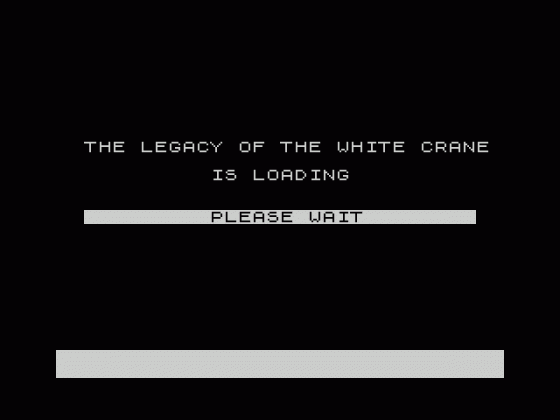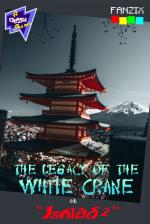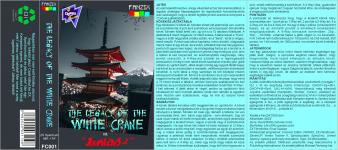

| Genre: | Game: Puzzle |
| Publisher: | Fanzix |
| Cover Art Language: | Hungarian |
| Machine Compatibility: | Spectrum 48K, Spectrum 128K, Spectrum +2, Spectrum +3 |
| Release: | Released as Public Domain software on Cassette |
| Available For: | Spectrum 48K/128K/+2/+3 |
| Compatible Emulators: | ZXSpin (PC (Windows)) Nutria (PC (MS-DOS)) |
| Original Release Date: | 11th March 2020* |
| Box Type: | Not a physical item so no box |
| Author(s): | m/ZX |
Variant Items
There are 0 other items featuring this same game (that we know about!). Click any of them for their details.
Active Auctions
Closed Auctions
Buy It
Unfortunately no-one is currently selling this item.
Auction Price Watch
Worried you're being ripped off? Closing prices on eBay can help you decide what a reasonable price is for a particular item.

Al's Spectrum Annual
9th January 2022
Like the original Ishido, Legacy Of The White Crane represents an enjoyable diversion from the plethora of action titles. Read Review
Full Instructions
Gameplay
From the first move of this ancient puzzle game your deepest powers of strategy and concentration will be called upon as you match 72 stones on a board of 96 squares.
Stones & Game Board
A stoneset consists of 72 stones. Every stone has two attributes: a color and a symbol. There are 6 colours and 6 symbols in each stoneset, thus creating 36 unique stones. Each stone comes in a pair, hence 72 stones in each stoneset. The Game Board is 8 squares high by 12 squares wide. The "Beyond" is the dark squares around the outer edges of the board, and the "Within" consists of the light interior squares. Only stones placed in the Within score points. Stones placed in the Beyond do not score points, but are strategically valuable. The Touchstone displays the next stone to be played (the upper right corner). The Scoreboard (under the Table) shows the number of points scored, the number of 4-Way matches achieved, the number of jokers, and the highest score, which you reached since the loading of the game. The Pouch (under the Touchstone) shows a representation of the number of stones remaining to be played. The game begins with the unique opening tableau of six stones on the board and a pouch of randomly ordered stones. The opening tableau consists of stones placed at each of the four corners and at two centre squares. Each of the 6 symbols and 6 colours are represented. The basic objective of the game is to empty the pouch of stones, placing them all on the board. Certain rules must be followed, and the more "4-Way Matches" that are achieved, the better the game. The game ends when a stone cannot be placed legally or the entire pouch of 72 stones has been emptied.
Rules
Stones are placed on the board, one at a time, after first being displayed on the Touchstone. The stone is placed from the Touchstone to the board by pointing the cursor at the square where the stone is to be placed and then pressing the fire button. Each stone must be placed adjacent (above, below, to the left or right - not diagonal) to another stone. A stone can only be placed beside another stone when the two stones have at least one of the two attributes in common. If a stone is placed such that its sides are adjacent to two other stones (2-Way match), it must match a different attribute in each of those two stones (symbol of one, colour of the other). The same attribute cannot be used to match both adjoining stones. A 3-Way match requires each of the two attributes to be present. A 4-Way match, when a stone is placed in the centre of four other stones, requires matching two of the stones with one attribute and matching the other two with the second attribute. 4-Way matches are rare, and it takes practice to learn how to create them. Yet, they are desirable and a primary goal of the game.
Scoring
Scoring for a legal match is determined by the number of sides the stone touches other stones (above, below, left, right) as it is played: 1 point for a 1-Way match, 2 points for a 2-Way match, 4 points for a 3-Way match, and 8 points for a 4-Way match. When a 4-Way is made, a bonus is paid and the points made for subsequent matches are thereafter doubled. 4-Way bonuses in sequence: 25p., 50p.,...,50.000p. There is a bonus given at the end of the game when there are fewer than three stones left in the pouch: 100 points with 2 stones left, 500 points with 1 stone left, 1000 points if the pouch is emptied.
Game Modes
There is a single player solitaire mode, where you can request help five times during the game. Dalgon, the monk can help you place the stones, undo the last step, and show or remix the pouch. You can also play with the computer, in the cooperative mode. In this case, you and Dalgon place one stone alternately and you cannot ask for help from Dalgon.
Loading
LOAD"" (ENTER)
On Spectrum 128K models, use Tape Loader.
Game Controls
The game can be controlled by multiple key combinations (move keys, fire key and main, help menu keys : QAOP+Sp+MH, QAOP+M+SpH, IJKL+A+MH). It can also be controlled by Joystick interfaces (Kempston, Sinclair, Cursor), in which case the main and help menus can be accessed with the M and H keys. Finally, Kempston Mouse can be used for control, in which case the left button is the fire, the right button is the help menu, and the middle button is the main menu. The main menu is also accessible by pressing the M key. And.... in main menu: M+Z+X... Try it!
Published by FanZiX in 2020
Written by M/ZX
Music by David Willis (zxtunes.com)
Inlay photo by Life of Wu (pexels.com)
ZX7 data compressor by Einar Saukas
Programs used: Crimson Editor, PASMO, ZX-Paintbrush, SevenUP, Vortex Tracker II, Spectaculator, SpecEmu, Unreal Speccy, Jspeccy and many emulators, Tapir, ZX-Blockeditor...
The original game is released 1989 on Macintosh by Publishing International. Original design by Michael Feinberg.
JÁTÉK
Az első lépéstől kezdve, ahogy elkezded ezt az ősi kirakós játékot, a legjobb stratégiai képességedre és legmélyebb koncentrációdra lesz szükséged, hogy a lehető legtöbb pontot szerezve elhelyezd a 72 követ a játéktáblán.
KÖVEK ÉS JÁTÉKTÁBLA
Egy kőkészlet 72 kőből áll. Minden kőnek két jellemzője van: a színe és a szimbóluma. 6 szín és 6 szimbólum ad ki összesen 36 különféle követ. Minden kőből kettő van, így jön ki a 72 darabos kőkészlet. A játéktábla 8 mező magas és 12 mező széles. A tábla részei a ”Kívül”, vagyis a sötét négyzetek a tábla szélén, és a ”Belül”, tehát a világos, belső mezők. Pontot csak akkor kaphatsz, mikor a belső, világosabb részre raksz ki egy követ, de a külső, sötétebb részt se hanyagold el, pontot ott ugyan nem kapsz, de stratégiailag fontos ez a terület is. A jobb felső sarokban lévő ugrókövön jelenik meg mindig az a kő, amit a táblán el kell helyezned. Az eredménytábla megmutatja, hány pontot szereztél, a 4-Way-eid számát és a legmagasabb pontszámot. A még ki nem rakott kövek számát az erszény jelzi (jobb oldalon az ugrókő alatt). Játék elején mindig egy egyedi táblát kapsz hat kővel és az erszényben a maradék, véletlenszerűen elrendezett kövekkel. A nyitó tábla a négy sarokban és két középső mezőn elhelyezett kövekből áll. Mind a 6 szimbólum és 6 szín képviselteti magát a hat kezdő kőben. A játék alapvető célja, lényege, hogy mind a 72 követ lerakd a táblára, amihez bizonyos szabályokat be kell tartanod, és a pontszámod növelése érdekében minél több ”4-Way”-t kell elérned. A játék akkor ér véget, amikor az ugrókövön lévő következő kő nem hozható játékba, tehát nem rakható le egyetlen üres mezőre sem szabályosan, vagy ha már az összes követ kiraktad a táblára.
SZABÁLYOK
A kövek táblára kerülése előtt megjelennek az ugrókövön. A követ ezután a kurzor mozgatásával és a tűz gomb megnyomásával tudod elhelyezni a táblán. Minden kő csak úgy rakható a táblára, ha van szomszédja (fent, lent, balra vagy jobbra - nem átlósan!). Egy kő csak olyan másik kő mellé helyezhető, amelyiknek egyik jellemzője megegyezik a lerakott kővel, vagyis a színük vagy a szimbólumuk megegyező. Ha egy követ két másik kő közé helyezel el (2-Way), akkor annak a színe meg kell, hogy egyezzen az egyik kő színével, míg a másik kővel pedig a szimbólumának kell megegyeznie. Ugyanaz a jellemző tehát nem használható mindkét szomszéd kőhöz. A három kő közé rakáshoz (3-Way) mindkét jellemzőnek jelen kell lenni. A 4-Way az, mikor egy követ négy másik kő közé raksz le. Ehhez minimálisan szükséges, hogy két kővel egyezzen a szín, másik kettővel pedig a szimbólum. A 4-Way ritka, gyakorlást igényel, hogy megtanuld, hogyan hozhatod létre, de szükségesek a magas pontszám eléréséhez.
PONTOZÁS
A pontozást az határozza meg, hogy a lerakott kőnek hány szomszédja van: 1 pont jár az 1-Way-ért, 2 pont jár a 2-Way-ért, 4 a 3-Way-ért, és 8 a 4-Way-ért. Ha egy 4-Way-t elérsz, bónuszpontot kapsz, és az elérhető pontok a következő lerakásokért megduplázódnak. A 4-Way bónuszok sorrendben: 25p., 50p.,…,50.000p. Jutalmat kapsz a játék végén is, ha kevesebb, mint 3 követ nem tudtál elhelyezni: 100 pontot, ha 2 kő maradt, 500 pontot, ha 1 kő maradt, és 1000 pontot, ha minden követ kiraktál a táblára.
JÁTÉKMÓDOK
Van egy passziánsz mód, mikor ötször kérhetsz segítséget egy játék alatt. Dalgon, a szerzetes segíthet neked abban, hogy megmutatja, hová tudod elhelyezni az aktuális követ, visszavonhatja az utolsó lépésed, valamint megmutathatja, vagy meg is keverheti neked az erszény tartalmát. Másik játékmód, mikor a számítógéppel, vagyis Dalgonnal játszol, ilyenkor felváltva raktok ki egy-egy követ, de ebben az esetben nem kérhetsz segítséget a játék során.
IRÁNYÍTÁS
A játék különféle billentyűkombinációkkal vezérelhető (mozgás + tűz + fő és segítség menü billentyűje: QAOP+Sp+MH, QAOP+M+SpH, IJKL+A+MH). Használhastz még elterjedt Joystick vezérlőket (Kempston, Sinclair, Cursor), ezekben az esetekben a főmenüt és a segítség menüt az M és H billentyűkkel éred el. Végül használhatsz akár Kempton egeret is, ilyenkor a bal egérgomb a tűz, a jobb egérgomb a segítség, és a középső egérgomb a főmenü, de utóbbi az M billentyűvel is elérhető. És.... a főmenüben: M+Z+X… próbáld ki!
Kiadta a FanZiX 2020-ban
Készítette: M/ZX
Zene: David Willis (zxtunes.com)
Borítókép: Life of Wu (pexels.com)
ZX7 tömörítés: Einar Saukas
Felhasznált programok: Crimson Editor, PASMO, ZX-Paintbrush, SevenUP, Vortex Tracker II, Spectaculator, SpecEmu, Unreal Speccy, Jspeccy and many emulators, Tapir, ZX-Blockeditor...
Az eredeti játékot 1989-ban jelentette meg Macintoshra a Publishing International. Az eredeti játékot Michael Feinberg írta.
Screen Designers
The following utilities are also available to allow you to edit the supplied screens of this game:
Cheats
Download
A digital version of this item can be downloaded right here at Everygamegoing (All our downloads are in .zip format).
| Download | What It Contains |
|---|---|
| A digital version of The Legacy Of The White Crane suitable for ZXSpin (PC (Windows)), Nutria (PC (MS-DOS)) |
Report A Problem
We thank you from the bottom of our hearts if you report something wrong on our site. It's the only way we can fix any problems!
You are not currently logged in so your report will be anonymous.
Add Note
Release Country
Change the country to update it. Click outside of this pop-up to cancel.
Scan Of Selected Article
If you auction an item, it will no longer show in the regular shop section of the site.







